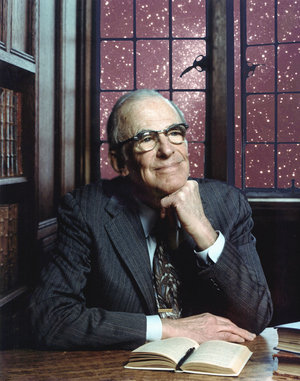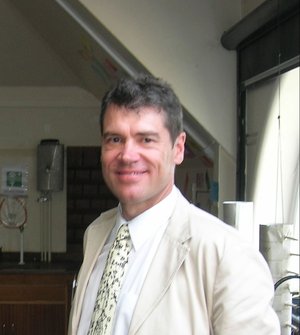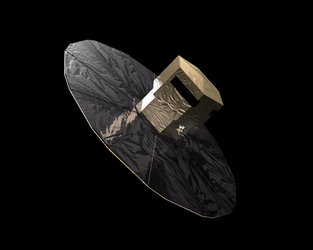Michael Perryman: Mapping the stars with maths
Space is the domain of astronomical values. To measure the Universe around us, we need tools adapted to deal with numbers larger than those needed for measurements on Earth and the ability to solve some of the most complex mathematical riddles ever designed. This is a job for someone who loves mathematics and who sees the 'big picture'.
Michael Perryman was born on 21 September 1954 in Luton, north of London. The son of a biology teacher, he grew up with a real passion for numbers. When the world was witnessing the race to the Moon, Perryman was busy demonstrating his ability with numbers and solving difficult algebra problems. When men first walked on the Moon, his interest had deepened to studying number theory.
In 1973 when he had to decide what to study at university, his maths teacher advised him against mathematics and instead said to choose a practical subject with better employment prospects. He was selected for Cambridge University where he decided to study theoretical physics. With no specific idea of what he wanted to do in the future, this subject seemed to provide the largest range of options and allow him to continue juggling with numbers.
His main field was high-energy physics, but when he started his PhD in 1976, he changed to astrophysics allthough he was still a pure theoretician who had never looked into a telescope. The astrophysics department at Cavendish Laboratory in Cambridge was, and is, a very exciting environment for young scientists and, at the time it was run by Sir Martin Ryle and Anthony Hewish, who had just been awarded the joint Nobel Prize for Physics for their work in radio astronomy and the discovery of pulsars.
First steps in astrophysics
As part of this highly motivated group, Michael Perryman focused on radio astronomy, looking at the cosmological aspects of radio sources. At the end of his PhD, he became involved for the first time in space when he began studying some of the radio sources in other parts of the spectrum.
This led him to conduct his first astronomical observations at the Mount Palomar observatory with James Gunn, the discoverer of the Gunn-Peterson effect for the redshift of quasars, a specialist in the search for 'dark matter' and the originator of the Sloan Digital Sky Survey. This also enabled him to witness a real revolution in astronomy by being one of the very first users of Charged-Coupled Device (CCD) data.
He also made his first contact with ESA as he was an early user of its International Ultraviolet Explorer (IUE) satellite, jointly developed with NASA and the British Science and Engineering Research Council (SERC).
CCDs and ultraviolet space astronomy on IUE were forerunners for the major revolution under preparation in the late 1970s: the launch of a space telescope. Prof. Malcolm Longair, who supervised Perryman's PhD, was European advisor to the Hubble Space Telescope project and in contact with Duccio Macchetto, the project scientist for the Faint Object Camera (FOC), ESA's major contribution to the Hubble Space Telescope. Macchetto was looking for someone to assist him and Longair suggested his young protégé Perryman.
In 1980, Perryman became the support astronomer at ESA for IUE. His job was to back up resident astronomers and he spent his time working at ESTEC in the Netherlands and the Villafranca station in Spain. The shift from theory to practice, and from radio to optical astronomy, was complete.
The dawn of space astrometry
In 1981 ESA approved a new mission in a new astronomical field. The High Precision Parallax Collecting Satellite (Hipparcos) was developed to determine the position and distance of more than 100 000 stars with an accuracy improved by a factor of 10 to 100 compared to ground-based observations. In the process, it would also collect data on their proper motion and variability, and identify binary systems.
Perryman was selected for the post of project scientist for the Hipparcos mission. Aged just 26, it was a highly challenging post and he worked hard for many years to ensure the mission’s success.
In the early 1980s, astrometry was still a fairly obscure area, and the Hipparcos mission concept turned out to be an incredible technological and computational challenge of great mathematical elegance. Using two finely aligned telescopes, the satellite would scan the sky for three years. Eventually, more than 1 terabit of data was collected to be processed through a gigantic matrix to reconstruct the actual positional data by correlating the relative position of stars. For Perryman, the mathematical aspect of the mission was at least as exciting as the basic science it would eventually produce.
As project scientist, he had to ensure the mission went beyond producing mere data and delivered real and valuable science. This meant ensuring data were collected and checked correctly, that the spacecraft was calibrated on the ground and later in space, that data processing was performed correctly, and that the results were published and made available to the astronomical community.
To achieve these objectives, he coordinated the work of some 200 scientists and to select the 100 000 stars for observation, an input catalogue (Inca) was compiled and three teams assigned to competitively develop the data reduction process.
Saving the mission
Hipparcos should have been launched into geostationary transfer orbit by an Ariane launcher on 8 August 1989. Unfortunately, its apogee kick motor did not fire and it could not reach its planned orbit. The first estimates were pessimistic. On its actual orbit the satellite was exposed to high radiation levels twice a day and its lifetime could be reduced to a few months, although the mission required it to scan the sky for 2.5 years before starting to deliver results.
With support from technical and operational teams in ESTEC and ESOC, the mission was eventually saved and conducted from its unplanned orbit. After a few weeks of uncertainty, it appeared that the satellite could have a longer lifetime than expected and to deal with limited visibility, more ground stations were added to the tracking network. The scientific community also provided support by adapting operations to the new environment.
By November 1989, Hipparcos started its operational mission and Perryman took over the programme management. For 2.5 years, he lived under a 'sword of Damocles' as radiation levels knocked down the satellite gyroscopes one after the other.
The mission actually lasted 3.5 years before the satellite's electronics eventually died. Processing and cataloguing the data took another three years. The Hipparcos Catalogue, with 118 218 entries, was finalised on 8 August 1996. A less accurate 'Tycho Catalogue', derived from redundant star mappers of the satellite's attitude control system and incorporating 1 058 332 star positions, was also compiled. In 1997 the data set was published in 17 volumes.
Beyond Hipparcos
The Hipparcos follow-on mission did not take long to emerge. In 1993, Perryman, together with Lennart Lindegren from the Lund Observatory in Sweden who worked on Hipparcos data processing, jointly proposed a more ambitious mission to take advantage of technological advances such as CCDs (unavailable for Hipparcos) and large lightweight mirrors. In 1995, Perryman was named study scientist for the new concept, named Gaia.
The mission was approved by ESA's Science Programme Committee in 2000 and Perryman appointed project scientist. By then, many scientists were using Hipparcos data and excited by the outcome, now wanted more measurements with a higher accuracy.
From the ground, star positioning accuracy is about 1 arc second. Hipparcos improved it to 1 milli-arc second and Gaia is expected to reach 10 micro arc second. Moreover, the number of stars to be mapped will increase from 100 000 to 1 billion, i.e. about 1% of our galaxy, enough to start building a three-dimensional map of the Milky Way showing its spiral arms. Unlike Hipparcos, Gaia will also detect the radial motion of stars, i.e. their velocity toward the Sun. This will enable detection of the motion of the galactic arms, of the star clusters and ultimately, of the Sun itself. It will also enable detection of large 'exoplanets' around nearby stars. Some 2000 planets could be found.
The launch of Gaia is scheduled for 2011. It will be located at the L2 Lagrangian point, some 1.5 million km from Earth in the opposite direction from the Sun, where ESA's Herschel and Planck are placed in 2009, and where the NASA/ESA/CSA James Webb Space Telescope will be deployed in 2013.
Perryman spends most of his time mapping the skies but he also confesses to passions for hiking and speleology. In 2006 he stood down from the Gaia programme to return to scientific research, compiling works derived from the results of Hipparcos. Just as he enjoys exploring deep caves, he also loves digging in scientific publications, in search of unexpected discoveries hidden deep in the data sets.
He is also already thinking of what could come after Gaia. With a 100 nano-arc second accuracy, he estimates that exoplanets up to 300 light years away could be detected.
“This won't happen soon,” says Perryman, “Not even during the Cosmic Vision plan for space exploration, but we have to prepare for the next generation of scientists and give them the opportunity to have their own share of exciting discoveries.”









